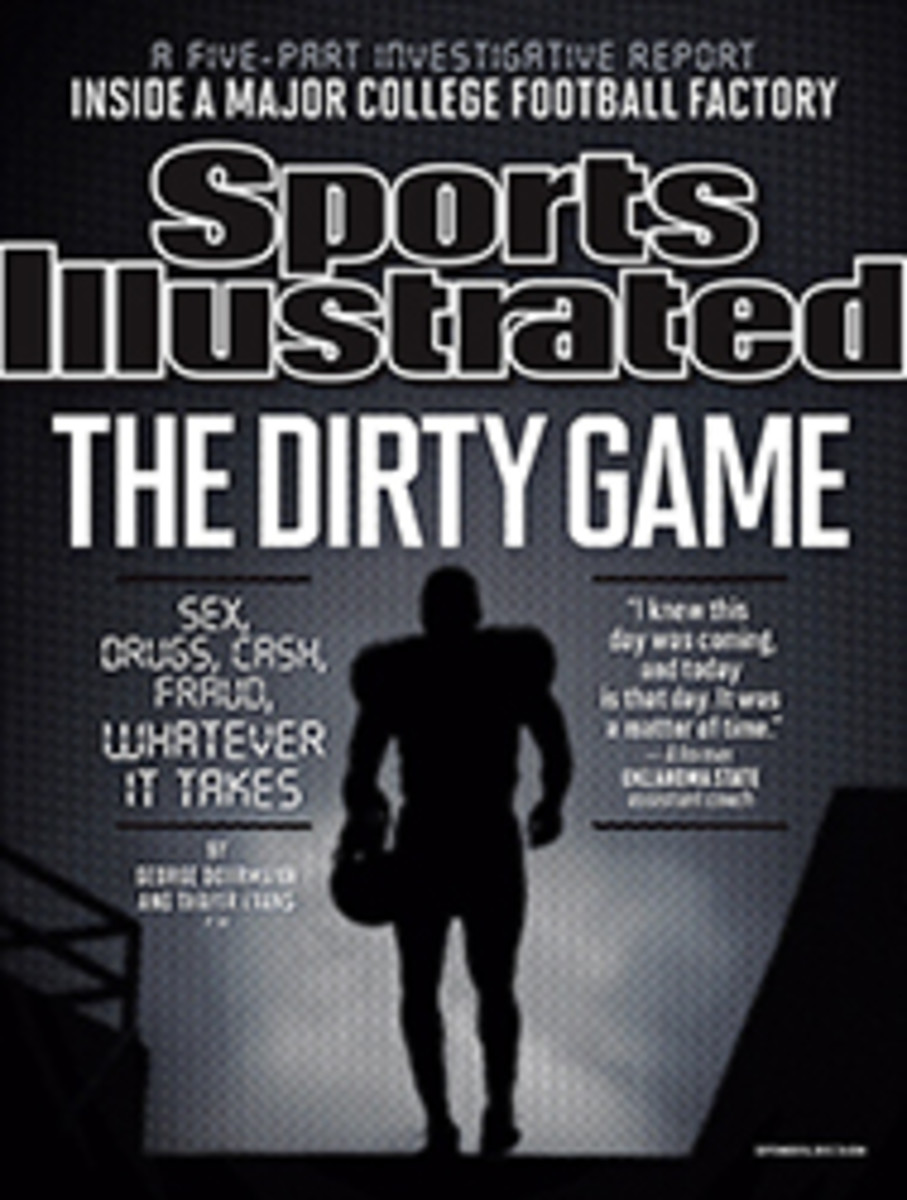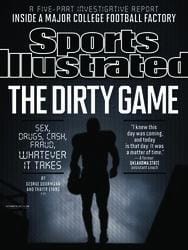
TIPPING POINT
TEXAS AND USC ARE STRUGGLING, AND THEIR COACHING SEATS ARE HOT. YOU KNOW THAT. BUT HOW THESE SCHOOLS HANDLE REGIME CHANGE COULD HAVE SEISMIC IMPLICATIONS FOR THE SPORT
THAT NIGHT in Pasadena still glows almost eight years later, all that burnt orange and cardinal in the Rose Bowl mirroring the twilit backdrop of the San Gabriel Mountains. The play on the field was no less beautiful, a high-scoring, seesaw contest that turned on a fourth-down stand and a quarterback's historic night. When Texas beat USC 41--38 for the BCS title on Jan. 4, 2006, there was nothing to suggest an end to the reign of the Longhorns and the Trojans atop college football. Texas and USC were too hot, too powerful, too damn desirable to every recruit in their talent-soaked states and beyond.
As confetti rained on Texas quarterback Vince Young, a day like last Saturday seemed impossible. A bunch of two- and three-star recruits at BYU rushing for a school-record (for both programs) 550 yards against the routed Longhorns? The Trojans failing to complete a pass longer than eight yards in a home loss to Washington State? About 10 miles of 110 freeway separate the site of the epic 2006 duel between Young and Reggie Bush and Los Angeles County's other major football stadium, where USC fans made their displeasure heard. As coach Lane Kiffin and his team left the field following their 10--7 loss, the crowd chanted "Fi-re Kif-fin!"
Texas coach Mack Brown escaped the same fate because the Longhorns had the good sense to get steamrolled in Provo, Utah. But back in Austin, Geoff Ketchum watched his site's message boards and marveled. The publisher of the popular Texas fan site Orangebloods.com, Ketchum has read his share of grousing about Brown, but he had never seen a night quite like this. "There wasn't any in-house [debate]," Ketchum says. "There was no Mack Brown support whatsoever."
Neither fan base got its ultimate wish on Sunday, but there was one firing. Brown jettisoned defensive coordinator Manny Diaz and replaced him with Greg Robinson, whom Brown had brought on as an analyst in July. That months ago Brown had put into place a backup plan for Diaz speaks to the troubling dysfunction in Austin. Robinson's hiring doesn't inspire any immediate confidence either. Since leaving Austin, the new coordinator has had disastrous tenures as Syracuse's head coach and as Michigan's defensive coordinator. Something, however, needed to be done. "Our performance on defense [Saturday] night was unacceptable, and we need to change that," Brown said in a press release announcing the change.
These programs need more than change at the coordinator level. Unless Brown and Kiffin can pull their teams out of their respective tailspins, their administrations will soon replace them. That's where the story could get really interesting. The last time two similarly pedigreed programs had simultaneous head coach openings, the balance of power in college football shifted.
THE SEASON that ended with Texas and USC in the Rose Bowl was notable for another reason: Florida and Notre Dame were both breaking in new coaches. Near the end of the 2004 season, Florida had fired Ron Zook and Notre Dame had fired Ty Willingham. Each school targeted the same coach, Utah's Urban Meyer, who chose Florida. Notre Dame then hired New England Patriots offensive coordinator Charlie Weis.
While Texas and USC marched toward their Rose Bowl showdown, Meyer's team got shredded at Alabama, and he shed tears after a loss to LSU. On the flight back from yet another loss, at South Carolina, Meyer kept his team on the plane at the Gainesville airport and questioned who truly wanted to be a part of the program. Soon after the end of the '05 season, though, the revival was under way; it was, in fact, immediate. Meyer signed quarterback Tim Tebow, receiver Percy Harvin and linebacker Brandon Spikes, who would bolster a group of elite athletes signed by Zook. In '06, Florida played its way into the BCS title game, throttled the undefeated Ohio State Buckeyes and started the SEC's seven-year national title streak.
Four days before that Florida--Ohio State game, Alabama officially announced it had hired Miami Dolphins coach Nick Saban. The Crimson Tide, having lost in Gainesville in 2006, had seen the monster Meyer was building. To beat Florida—and LSU and Georgia—Alabama needed a coach who could win titles and that's what it got. Meyer and Saban have won five of the past seven national championships. Florida's hiring of Meyer was the first domino, which led to Saban, which led to the game's tectonic shift away from Texas and USC and toward the megaprograms of the SEC.
WE KNOW what precipitated USC's decline. After finding that prospective agents had given Bush improper benefits throughout his college career, the NCAA hit USC with sanctions in 2010. Those penalties included a two-year bowl ban and scholarship reductions that really sank in last year, when the Trojans faced depth issues on the offensive line. USC has one more recruiting class capped at 15 (as opposed to the standard 25), but a change this off-season would give the next coach a full year to recruit USC's first full postsanctions class. Given the wealth of talent in Southern California and the eternal, sun-kissed attractiveness of the program outside the state, it shouldn't take long to restore USC as a worthy challenger to the SEC.
Texas has no such excuse. The Longhorns kept winning for a while after that 2006 Rose Bowl, returning to Pasadena at 13--0 after the '09 season to face Alabama for the national title. Since the departure of quarterback Colt McCoy after that game, however, Texas has yet to settle on a new identity. First, Brown wanted to mimic Alabama's power offense. That led to a 5--7 season in '10. Defensive coordinator Will Muschamp left after that season to replace Meyer at Florida, and Brown hired Diaz, who had used cutting-edge schemes at Middle Tennessee State and Mississippi State to build dominant defenses. The Longhorns were just 8--5 in 2011 and 9--4 in '12. With 10 offensive and nine defensive returning starters in a wide-open Big 12, this was supposed to be a breakthrough season. If Brown couldn't right the ship with this group, Texas had big problems.
Those problems became apparent on Saturday when BYU quarterback Taysom Hill raced away from the Texas defense for a 68-yard first-quarter touchdown. Hill would run for 259 yards in BYU's 40--21 win. No one even bothered to joke whether Brown had attempted to recruit Hill—the pride of Pocatello, Idaho—as a defensive back. Unlike Heisman Trophy--winning Texan quarterbacks Robert Griffin III and Johnny Manziel, whose only interest from Texas famously involved roles in the secondary, Hill wasn't on the Longhorns' radar until Saturday. Maybe if Manziel had chosen to play safety for Texas, someone might have been able to tackle Hill.
The Longhorns have turned doing less with more into a form of comic performance art. No other program—not Alabama, Ohio State, not even Oregon—has the resources Texas has. In the fiscal year ending Aug. 31, 2012, Texas reported $103.8 million in football revenue to the U.S. Department of Education. The Texas athletic department is the only one in the country with its own branded cable network run by ESPN. Since 2009, Texas has signed 77 recruits ranked four stars or higher by Rivals.com. BYU has signed nine such players in the same period.
All this suggests that the right coach could quickly turn Texas around. The Longhorns' recruiting dominance in the Lone Star State has taken a hit thanks to the ascension of coach Kevin Sumlin at Texas A&M, but some new blood in Austin could leverage the advantages at Texas and create a juggernaut. "[The team] needs a different mind-set than what's currently there, but it's a great job," says Scott Roussel, who runs FootballScoop.com, the coaching industry's version of CNN. "Nobody would say no to that job. And as crazy as it sounds, the expectations aren't Alabama expectations."
THERE WAS a time when Kiffin looked like the coach who could restore the student-body-right shine to USC. Using a roster recruited mainly by predecessor Pete Carroll, Kiffin went 10--2 and had a signature win at Oregon in his second season. That led to a No. 1 preseason ranking in 2012, but Kiffin led that team to a 7--6 record and closed the season with an embarrassing Sun Bowl loss to Georgia Tech. Before this season USC athletic director Pat Haden publicly supported Kiffin and advised patience as the Trojans replaced quarterback Matt Barkley with sophomores Cody Kessler and Max Wittek, but Saturday's loss proved the problems extend beyond one position. So the fans remaining in the Coliseum after the loss gave Haden some pointed advice. Kiffin heard the chants and the boos. "I think I heard those before the game started, actually," he said. "I'm getting used to it."
Early Sunday morning the Longhorn Network was supposed to show a replay of the BYU game. Instead viewers saw a replay of the Texas women's volleyball team's win against top-ranked Penn State. ESPN spokeswoman Keri Potts wrote in an email that network officials decided the volleyball match took priority because it was a compelling five-game match featuring the defending national champ.
At USC the coach has grown accustomed to hearing boos from his own team's fans. At Texas the volleyball team takes priority over the football team. No one on the field in Pasadena that January evening in 2006 would have imagined this.
Yet here they are.
Early Sunday morning the Longhorn Network was supposed to show a replay of the BYU game. Instead viewers saw a replay of the Texas women's volleyball team's win against Penn State.
Given the wealth of talent in Southern California and the eternal, sun-kissed attractiveness of the program outside the state, it shouldn't take long to restore USC as a worthy challenger to the SEC.
SI.COM
For more from Andy Staples, and to read up on the best games, biggest rivalries and potential upsets in Stewart Mandel's College Football Pickoff column every Friday, go to SI.com/mag
PHOTO
Photograph by ROBERT BECK/SPORTS ILLUSTRATED
JAN. 4, 2006 BCS TITLE GAME Young and USC put on a historic show, suggesting a long stretch of twin dominance. It didn't happen.
PHOTO
RICK BOWMER/AP (ASH)
BURNED ORANGE Texas QB David Ash (14) was sacked three times and suffered head and shoulder injuries in the loss to BYU, leaving Brown (below) with few options.
PHOTO
JOHN ALBRIGHT/ICON SMI (BROWN)
[See caption above]
PHOTO
CHRIS WILLIAMS/ICON SMI (KESSLER)
PICKED, 6 Kiffin says he heard the boos pre- and postgame. In between he watched Kessler (6) errantly throw a crucial interception.
PHOTO
JOHN PYLE/CAL SPORT MEDIA (KIFFIN)
[See caption above]

